 W
WBroadly speaking, liberty is the ability to do as one pleases, or a right or immunity enjoyed by prescription or by grant. It is a synonym for the word freedom. In modern politics, liberty is the state of being free within society from control or oppressive restrictions imposed by authority on one's way of life, behaviour, or political views. In philosophy, liberty involves free will as contrasted with determinism. In theology, liberty is freedom from the effects of "sin, spiritual servitude, [or] worldly ties". Sometimes liberty is differentiated from freedom by using the word "freedom" primarily, if not exclusively, to mean the ability to do as one wills and what one has the power to do; and using the word "liberty" to mean the absence of arbitrary restraints, taking into account the rights of all involved. In this sense, the exercise of liberty is subject to capability and limited by the rights of others. Thus liberty entails the responsible use of freedom under the rule of law without depriving anyone else of their freedom. Freedom is more broad in that it represents a total lack of restraint or the unrestrained ability to fulfill one's desires. For example, a person can have the freedom to murder, but not have the liberty to murder, as the latter example deprives others of their right not to be harmed. Liberty can be taken away as a form of punishment. In many countries, people can be deprived of their liberty if they are convicted of criminal acts.
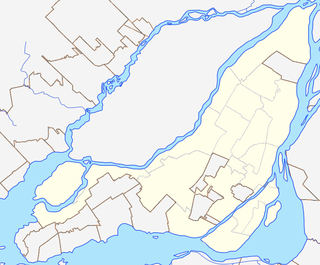 W
WThe Sir George-Étienne Cartier Monument is a monument in Montreal, Quebec, in the Mount Royal Park to George-Étienne Cartier by sculptor George William Hill (1862–1934).
 W
WA choice is the range of different things from which you can choose. The arrival at a choice may incorporate motivators and models. For example, a traveler might choose a route for a journey based on the preference of arriving at a given destination at a specified time. The preferred route can then account for information such as the length of each of the possible routes, the amount of fuel in the vehicle, traffic conditions, etc.
 W
WColumbia is the female national personification of the United States. It was also a historical name applied to the Americas and to the New World. The association has given rise to the names of many American places, objects, institutions and companies; such as: Columbia University, the District of Columbia, "Hail, Columbia" as well as the ship Columbia Rediviva, which gave its name to the Columbia River, and the Canadian province of British Columbia. Images of the Statue of Liberty largely displaced personified Columbia as the female symbol of the United States by around 1920, although Lady Liberty was seen as an aspect of Columbia. However, Columbia's most prominent display today is being part of the logo of the Hollywood film studio Columbia Pictures.
 W
WThe Efígie da República is used as a national personification, both in Brazil and in Portugal, symbolizing the Republic.
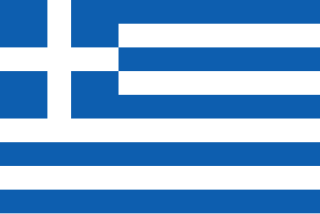 W
WEleftheria i thanatos is the motto of Greece. It originated in the Greek songs of resistance that were powerful motivating factors for independence. It was adopted in 1814 by the Filiki Eteria, a secret organization formed specifically for the overthrow of Ottoman rule.
 W
WThe Eureka Flag was flown at the Battle of the Eureka Stockade, which took place on 3 December 1854 at Ballarat in Victoria, Australia. It was the culmination of the 1851–1854 Eureka Rebellion on the Victorian goldfields, where miners protested against the cost of mining permits and the officious way the colonial authorities enforced the system along with other grievances. An estimated crowd of over 10,000 demonstrators swore allegiance to the flag as a symbol of defiance at Bakery Hill on 29 November 1854. Twenty-two miners were officially listed as killed at the Eureka Stockade, along with seven troopers and police. Around 120 miners were arrested, and many others badly wounded.
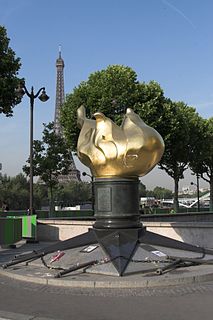 W
WThe Flame of Liberty in Paris is a full-sized, gold-leaf-covered replica of the flame of the torch from the Statue of Liberty. The monument, which measures approximately 3.5 metres in height, is a sculpture of a flame, executed in gilded copper, supported by a pedestal of gray-and-black marble. It is located near the northern end of the Pont de l'Alma, on the Place Diana, in the 16th arrondissement.
 W
WThe Freedom Bell in Berlin, Germany, is a bell that was given as a gift from Americans to the city of Berlin in 1950 as a symbol of anti-communism, and was inspired by the American Liberty Bell. Since 1950, the bell has been located in the Rathaus Schöneberg, the former city hall of West Berlin.
 W
WFreedom Bell, American Legion, is a public artwork located at Union Station in Washington, D.C., United States. A replica of the Liberty Bell, Freedom Bell, American Legion was surveyed as part of the Smithsonian's American Art Museum's Inventories of American Painting and Sculpture database in 1985.
 W
WFreedom Monument, located in Tahrir Square in the centre of Baghdad, is the city's most well-known and well-loved monument.
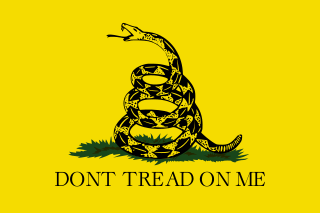 W
WThe Gadsden flag is a historical American flag with a yellow field depicting a timber rattlesnake coiled and ready to strike. Beneath the rattlesnake are the words: "Dont Tread on Me". Some modern versions of the flag include an apostrophe.
 W
W«Panormus conca aurea suos devorat alienos nutrit» (Palermo the golden dell, devours hers and feeds the foreigners. Latin inscription on the edge of the basin of the Genius statue at City Hall of Palermo.)
 W
WThe Goddess of Democracy, also known as the Goddess of Democracy and Freedom, the Spirit of Democracy, and the Goddess of Liberty, was a 10-metre-tall (33 ft) statue created during the 1989 Tiananmen Square protests. The statue was constructed over four days out of foam and papier-mâché over a metal armature. The constructors decided to make the statue as large as possible to try to dissuade the government from dismantling it: the government would either have to destroy the statue—an action which would potentially fuel further criticism of its policies—or leave it standing. Nevertheless, the statue was destroyed on June 4, 1989, by soldiers clearing the protesters from Tiananmen square. Since its destruction, numerous replicas and memorials have been erected around the world, including in Hong Kong, San Francisco, Washington, D.C., and Vancouver.
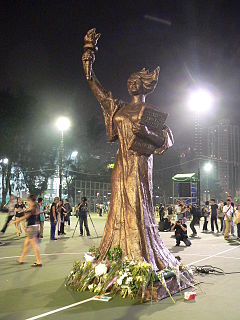 W
WHong Kong's Goddess of Democracy is a 6.4-metre faux bronze statue sculpted by Chen Weiming, inspired by the original 10-metre tall Goddess of Democracy. The original foam and papier-mâché statue was erected by the Chinese pro-democracy movement in Tiananmen Square at the end of May 1989, and destroyed by soldiers clearing the protesters from Tiananmen square on June 4, 1989.
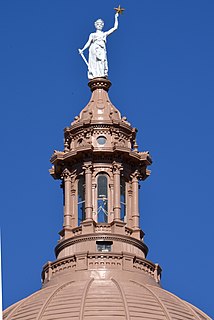 W
WGoddess of Liberty is a sculpture by Elijah E. Myers, installed atop the Texas State Capitol dome, in Austin, Texas, United States. The original statue was erected in February 1888. It was replaced by a replica on June 14, 1986, and the original was restored and relocated to the Bullock Texas State History Museum.
 W
WThe Great Seal of France is the official seal of the French Republic. After the 1792 revolution established the First French Republic, the insignia of the monarchy was removed from the seal. Over time, the new seal changed. At first, it featured Marianne, symbol of the revolution. It evolved to show that the people developed their culture and politics. In modern times, it depicts liberty, along with aspects of culture such as art, education, and agriculture.
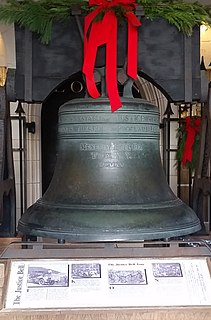 W
WThe Justice Bell is a replica of the Liberty Bell made in 1915. It was created to promote the cause for women's suffrage in the United States from 1915 to 1920. The bell is on permanent display at the Washington Memorial Chapel in Valley Forge National Park in Pennsylvania.
 W
WLady Liberty Hong Kong was a 3-metre (9.8 ft) statue that was created during the 2019–2020 Hong Kong protests, designed by users from the LIHKG forum. Created in August 2019, the statue was publicly displayed in multiple locations before being hauled to the top of Lion Rock, intended as the statue's "final resting place"; however, the statue was vandalised and removed by unknown assailants the next day.
 W
WLibertas is the Roman goddess and personification of liberty. She became a politicised figure in the Late Republic, featured on coins supporting the populares faction, and later those of the assassins of Julius Caesar. Nonetheless, she sometimes appears on coins from the imperial period, such as Galba's "Freedom of the People" coins during his short reign after the death of Nero. She is usually portrayed with two accoutrements: the rod and the soft pileus, which she holds out, rather than wears.
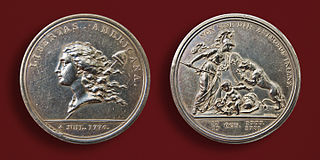 W
WThe Libertas Americana was a medal made to commemorate the American Revolution. It was designed in part by Benjamin Franklin.
 W
W"Liberté" (Freedom) has been the national anthem of Guinea since independence in 1958. It was arranged by Fodéba Keïta and was based on the melody of "Alfa yaya". The author of the lyrics is unknown.
 W
WLiberté, égalité, fraternité, French for "liberty, equality, fraternity", is the national motto of France and the Republic of Haiti, and is an example of a tripartite motto. Although it finds its origins in the French Revolution, it was then only one motto among others and was not institutionalized until the Third Republic at the end of the 19th century. Debates concerning the compatibility and order of the three terms began at the same time as the Revolution. It is also the motto of the Grand Oriente and the Grande Loge de France.
 W
WThe concept of liberty has frequently been represented by personifications, often loosely shown as a female classical goddess. Examples include Marianne, the national personification of the French Republic and its values of Liberté, Égalité, Fraternité, the female Liberty portrayed on United States coins for well over a century, and many others. These descend from images on ancient Roman coins of the Roman goddess Libertas and from various developments from the Renaissance onwards. The Dutch Maiden was among the first, re-introducing the cap of liberty on a liberty pole featured in many types of image, though not using the Phrygian cap style that became conventional. The 1886 Statue of Liberty by Frédéric Auguste Bartholdi is a well-known example in art, a gift from France to the United States.
 W
WThe Liberty Bell, previously called the State House Bell or Old State House Bell, is an iconic symbol of American independence, located in Philadelphia, Pennsylvania. Once placed in the steeple of the Pennsylvania State House, the bell today is located across the street in the Liberty Bell Center in Independence National Historical Park. The bell was commissioned in 1752 by the Pennsylvania Provincial Assembly from the London firm of Lester and Pack, and was cast with the lettering "Proclaim LIBERTY Throughout all the Land unto all the Inhabitants Thereof", a Biblical reference from the Book of Leviticus (25:10). The bell first cracked when rung after its arrival in Philadelphia, and was twice recast by local workmen John Pass and John Stow, whose last names appear on the bell. In its early years, the bell was used to summon lawmakers to legislative sessions and to alert citizens about public meetings and proclamations.
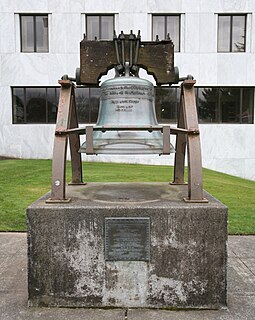 W
WThe Liberty Bell installed outside the Oregon State Capitol's west entrance, in Salem, Oregon, is a replica of the Liberty Bell in Philadelphia, Pennsylvania. The bell was presented to Oregon on July 4, 1950 by John Snyder, an American businessman and federal government official who served as United States Secretary of the Treasury in President Harry S. Truman's administration, to promote savings bonds.
 W
WLiberty Bell refers to one of two replicas in Portland, Oregon, United States, of the original Liberty Bell in Philadelphia. The first replica was purchased in 1962, and installed in the rotunda of City Hall in 1964. On November 21, 1970, it was destroyed in a bomb blast that also damaged the building's east portico. The second replica was installed outside of City Hall soon after the blast with funds from private donations. It was dedicated on November 6, 1975. The bell is listed as a state veterans memorial by the Oregon Department of Veterans' Affairs.
 W
WLiberty Displaying the Arts and Sciences, or The Genius of America Encouraging the Emancipation of the Blacks (1792) is an oil-on-canvas painting by the American artist Samuel Jennings.
 W
WLiberty dollar may refer to:Liberty dollar, a private currency produced in the United States Dollar coin, various dollar coins of the United States, including: Flowing Hair dollar, the first dollar coin issued by the United States federal government, depicting the goddess Liberty and bearing the inscription "Liberty", minted in 1794 and 1795 Draped Bust dollar, a United States dollar coin depicting the goddess Liberty and bearing the inscription "Liberty", minted from 1795 to 1803, and later reproduced in very limited quantities during the 1830s to 1850s bearing the date 1804 1804 dollar, an extremely rare dollar coin of the United States depicting the goddess Liberty and bearing the inscription "Liberty", a variant of the Draped Bust dollar, minted in very limited quantities from the 1830s to 1850s Gobrecht dollar, a dollar coin of the United States depicting the goddess Liberty, minted from 1836 to 1839 Seated Liberty dollar, a dollar coin of the United States depicting the goddess Liberty, minted from 1840 to 1873 Gold dollar, a gold dollar coin of the United States depicting the goddess Liberty, minted from 1849 to 1889 Trade dollar, a silver trade coin of the United States depicting the goddess Liberty, minted from 1873 to 1885 Morgan dollar, a dollar coin of the United States depicting the goddess Liberty, minted from 1878 to 1904, then again in 1921, and issued as a commemorative in 2021 Peace dollar, a dollar coin of the United States depicting the goddess Liberty and bearing the inscription "Liberty", minted from 1921 to 1928, again in 1934 and 1935, and issued as a commemorative in 2021 American Silver Eagle, a dollar coin of the United States depicting the goddess Liberty and bearing the inscription "Liberty", the official silver bullion coin of the United States, first produced in 1986
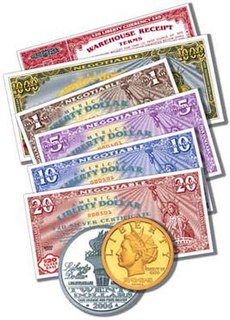 W
WThe American Liberty Dollar (ALD) was a private currency produced in the United States.
 W
WThe Liberty issue was a definitive series of postage stamps issued by the United States between 1954 and 1965. It offered twenty-four denominations, ranging from a half-cent issue showing Benjamin Franklin to a five dollar issue depicting Alexander Hamilton. However, in a notable departure from all definitive series since 1870, the stamp for a normal first-class letter—the 3-cent value—did not present the portrait of a president, but instead offered a monocolor image of the Statue of Liberty. Moreover, two-color renderings of the Statue of Liberty appeared on both the 8 cent and 11 cent stamps; and it is from these three denominations that the Liberty issue takes its name. Pictures of other national landmarks, such as Bunker Hill and Mount Vernon, are found on several values, while the rest of the stamps follow tradition, containing portraits of well-known historic Americans. The six denominations in the set that illustrate buildings were all designed in landscape format, resulting in a free intermixture of landscape and portrait orientation for the first time in a definitive U.S. issue.
 W
WLiberty Leading the People is a painting by Eugène Delacroix commemorating the July Revolution of 1830, which toppled King Charles X of France. A woman of the people with a Phrygian cap personifying the concept of Liberty leads a varied group of people forward over a barricade and the bodies of the fallen, holding the flag of the French Revolution – the tricolour, which again became France's national flag after these events – in one hand and brandishing a bayonetted musket with the other. The figure of Liberty is also viewed as a symbol of France and the French Republic known as Marianne. The painting is often confused for depicting the French Revolution.
 W
WLiberty Monument is a historic monument located at Ticonderoga in Essex County, New York. It was built in 1924 and is a bronze sculpture on a tiered granite base. The lower part of the sculpture is composed of four life-sized figures of a Native American, a Frenchman, a Scottish soldier, and an American. They symbolize the four groups whose military exploits are part of Ticonderoga's past. The second part is the artist Charles Keck's (1875–1951) interpretation of Liberty.
 W
WA liberty pole is a wooden pole, or sometimes spear or lance, surmounted by a "cap of liberty", mostly of the Phrygian cap form outside the Netherlands. The symbol originated in the immediate aftermath of the assassination of the Roman dictator Julius Caesar by a group of Rome's Senators in 44 BC. Immediately after Caesar was killed the assassins, or Liberatores as they called themselves, went through the streets with their bloody weapons held up, one carrying a pileus carried on the tip of a spear. This symbolized that the Roman people had been freed from the rule of Caesar, which the assassins claimed had become a tyranny because it overstepped the authority of the Senate and thus betrayed the Republic.
 W
WThe Statue of Liberty is a colossal neoclassical sculpture on Liberty Island in New York Harbor within New York City, in the United States. The copper statue, a gift from the people of France to the people of the United States, was designed by French sculptor Frédéric Auguste Bartholdi and its metal framework was built by Gustave Eiffel. The statue was dedicated on October 28, 1886.
 W
WThe Liberty Tree (1646–1775) was a famous elm tree that stood in Boston, Massachusetts near Boston Common, in the years before the American Revolution. In 1765, colonists in Boston staged the first act of defiance against the British government at the tree. The tree became a rallying point for the growing resistance to the rule of Britain over the American colonies, and the ground surrounding it became known as Liberty Hall. The Liberty Tree was felled by Loyalist Nathaniel Coffin Jr. in August 1775.
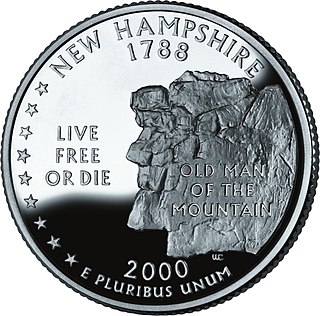 W
W"Live Free or Die" is the official motto of the U.S. state of New Hampshire, adopted by the state in 1945. It is possibly the best-known of all state mottos, partly because it conveys an assertive independence historically found in American political philosophy and partly because of its contrast to the milder sentiments found in other state mottos.
 W
WMarianne has been the national personification of the French Republic since the French Revolution, as a personification of liberty, equality, fraternity and reason, and a portrayal of the Goddess of Liberty.
 W
WLe Marron Inconnu de Port au prince, shortened as Le Marron Inconnu, also called Le Nègre Marron or Nèg Mawon, is a bronze statue of a runaway slave; better known as a maroon, standing in the center of Port-au-Prince, Haiti. Completed on September 22 1967 by Haitian architect Albert Mangonès, the statue is regarded as a symbol of black liberation; commemorating in particular, the rallying cry that sparked the Haitian Revolution and the abolishment of slavery. Situated across from the National Palace, it is the nation's most iconic representation of the struggle for freedom.
 W
WMiss Freedom, originally named Goddess of Liberty, is the statue adorning the dome of the Georgia State Capitol since 1889. Commissioned in 1888, the hollow copper statue is painted white, weighs over 1600 lbs and is over 26 feet tall. She was sculpted with a torch in her right hand and a sword in her left. The torch is a functioning mercury-vapor lamp, casting a blue-green light at night. The torch in her right hand was supposed to be a working light continuously, but it remained dark until it was reconstructed in 1959. Tube and trolley systems have been installed so the bulb can be changed from the inside.
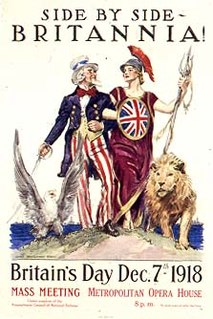 W
WA national personification is an anthropomorphic personification of a state or the people(s) it inhabits. It may appear in political cartoons and propaganda.
 W
WThe Phrygian cap or liberty cap is a soft conical cap with the apex bent over, associated in antiquity with several peoples in Eastern Europe and Anatolia, including the Balkans, Dacia and Phrygia, where the name originated. However the hat style seems to originate from Scythians as depicted in their art.
 W
WThe pileus was a brimless, felt cap worn in Ancient Greece, Etruria, Illyria, Pannonia and surrounding regions, later also introduced in Ancient Rome. In the 5th century BC a bronze version began to appear in Ancient Greece and it became a popular infantry helmet. It occasionally had a horsehair crest. The Greek πιλίδιον and Latin pilleolus were smaller versions, similar to a skullcap. The plis worn today in Albania and Kosovo is thought to originate from a similar felt cap worn by the ancient Illyrians.
 W
WThe Pirámide de Mayo, located at the hub of the Plaza de Mayo, is the oldest national monument in the City of Buenos Aires. Its construction was ordered in 1811 by the Primera Junta to celebrate the first anniversary of the May Revolution. It was renovated in 1856, under the direction of Prilidiano Pueyrredón. In 1912, after having undergone many modifications, it was moved 63 metres to the east, with the idea that a much larger monument would eventually be constructed around it.
 W
WThe Place de la République is a square in Paris, located on the border between the 3rd, 10th and 11th arrondissements. The square has an area of 3.4 ha. Named after the First, Second and Third Republic, it contains a monument which includes a statue of the personification of France, Marianne.
 W
WThe Rhodesian Independence Bell, or Rhodesian Liberty Bell, is a replica of the American Liberty Bell which was used in Rhodesia to commemorate their Unilateral Declaration of Independence. It weighed 250 pounds and was made in 1966 in the Netherlands and was last rung in 1978.
 W
WThe Seal of the United States Senate is the seal officially adopted by the United States Senate to authenticate certain official documents. Its design also sometimes serves as a sign and symbol of the Senate, appearing on its official flag among other places. The current version dates from 1886, and is the third seal design used by the Senate since its inception in 1789. The use of the seal is restricted by federal law and other regulations, and so is used sparingly, to the point that there are alternate, non-official seal designs more commonly seen in public.
 W
WThe Soldiers' National Monument is a Gettysburg Battlefield memorial which is located at the central point of Gettysburg National Cemetery. It honors the battle's soldiers and tells an allegory of "peace and plenty under freedom … following a heroic struggle." In addition to an inscription with the last 4 lines of the Gettysburg Address, the shaft with 4 buttresses has 5 statues:A large statue representing the concept of Liberty surmounts the pedestal. Eighteen large bronze stars circling the pedestal below this statue represent the eighteen Union states with buried dead. A statue is located at each corner near the base. They represent War, History, Peace, and Plenty. War is represented by a statue of an American soldier who recounts the story of the battle to History. In turn, History records, with stylus and tablet, the achievements of the battle and the names of the honored dead. A statue of an American mechanic and his tools illustrates Peace. Plenty is a female figure with a sheaf of wheat and the fruits of the earth that typify peace and abundance as the soldier's crowning triumph.
 W
WThe Statue of Freedom, also known as Armed Freedom or simply Freedom, is a bronze statue designed by Thomas Crawford (1814–1857) that, since 1863, has crowned the dome of the U.S. Capitol building in Washington, D.C. Originally named Freedom Triumphant in War and Peace, a U.S. government publication now states that the statue "is officially known as the Statue of Freedom." The statue depicts a female figure bearing a military helmet and holding a sheathed sword in her right hand and a laurel wreath and shield in her left.
 W
WThe Statue of Liberty is a colossal neoclassical sculpture on Liberty Island in New York Harbor within New York City, in the United States. The copper statue, a gift from the people of France to the people of the United States, was designed by French sculptor Frédéric Auguste Bartholdi and its metal framework was built by Gustave Eiffel. The statue was dedicated on October 28, 1886.
 W
WThe Statue of Liberty is a bronze statue erected at the harbor of Mytilene on the island of Lesbos in Greece.
 W
WThe Statue of The Republic is a 24-foot-high (7.3 m) gilded bronze sculpture in Jackson Park, Chicago, Illinois by Daniel Chester French. The 1893 original statue was destroyed by fire. The present statue is a smaller-scale replica, sculpted by the same artist, which was erected in 1918 in commemoration of both the 25th anniversary of the World's Columbian Exposition and the Illinois' statehood centennial. The statue is now located on the south end of the park at the intersection of East Hayes and South Richards Drive, adjacent the golf course and approximately where the exposition's Administration Building and Electricity Building once stood. The statue was funded by the Benjamin Ferguson Fund, which commissioned French to cast this recreation of the original 65-foot-tall (20 m) statue that stood on the grounds of the Exposition of 1893. Edith Minturn Stokes served as French's model for the original statue. Henry Bacon, the architect of the Lincoln Memorial, designed the festooned pedestal for the replica statue.
 W
WMajor General Comte Jean de Rochambeau is a bronze statue by Fernand Hamar which honors Jean-Baptiste Donatien de Vimeur, comte de Rochambeau, a French nobleman and general who played a major role in helping the Thirteen Colonies win independence during the American Revolution.
 W
WThe Stauffacherin is a Swiss legendary figure. According to Swiss folklore, she was the wife of Werner Stauffacher, the Landammann of the Canton of Schwyz and a founding father of the Old Swiss Confederacy. She was depicted in Friedrich Schiller's 1804 play William Tell as an advisor to her husband, advocating for Swiss independence from Habsburg rule. The image of the Stauffacherin, often viewed as the feminine counterpart to Wilhelm Tell, has become a symbol for Swiss national pride, democracy, and women's suffrage.
 W
WSvoboda ili smart, written in pre-1945 Bulgarian orthography: "Свобода или смърть" and before 1899: "Свобода или смъртъ", was a revolutionary slogan used during the national-liberation struggles by the Bulgarian revolutionaries, called comitadjis. The slogan was in use during the second half of the 19th and the first half of the 20th centuries.
 W
WAccording to the Book of Mormon, Captain Moroni was an important Nephite military commander who lived during the first century BC. He is first mentioned in the Book of Alma as "the chief captain over the Nephites."
 W
WWe Owe Allegiance to No Crown is a large 1814 oil on canvas painting by Philadelphian artist John Archibald Woodside. This painting was displayed in the National Portrait Gallery in Washington, D.C., for the exhibition, "1812: A Nation Emerges", from June 2012-January 2013.
 W
WThe World War I Memorial is located in Atlantic City, Atlantic County, New Jersey, United States. The memorial was built in 1922, and added to the National Register of Historic Places on August 28, 1981.